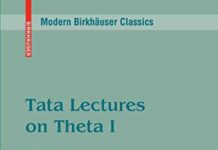
Ebook Info
- Published: 1999
- Number of pages: 304 pages
- Format: PDF
- File Size: 13.47 MB
- Authors: David Mumford
Description
Mumford’s famous “Red Book” gives a simple, readable account of the basic objects of algebraic geometry, preserving as much as possible their geometric flavor and integrating this with the tools of commutative algebra. It is aimed at graduates or mathematicians in other fields wishing to quickly learn aboutalgebraic geometry. This new edition includes an appendix that gives an overview of the theory of curves, their moduli spaces and their Jacobians — one of the most exciting fields within algebraic geometry.
User’s Reviews
Editorial Reviews: Review “This is the second edition of a famous and well-known introduction to algebraic geometry, written to show that the language of schemes is fundamentally geometrical and clearly expressing the intuition of algebraic geometry. … This book can strongly be recommended to anybody interested in algebraic geometry and willing to learn about varieties and schemes and their main problems.”EMS Newsletter, Vol. 37, Sept. 2000
Reviews from Amazon users which were colected at the time this book was published on the website:
⭐Well, this is a must have for algebraic geometers.
⭐This book is a must for any student in Algebraic Geometry or any student in Differential Geometry using algebraic techniques.
⭐When I received this magnificent product, I found out that it was indeed a book. Moreover, I understand that it was indeed written by David Mumford. Upon opening it, I saw that it discusses varieties, and also that it discusses schemes.However, the book fails to be as advertised in one key aspect: it is not red.
⭐In a nutshell, reading this book is like reading the mind of a great mathematician as he thinks about a great new idea. Anyone interested in schemes should read it. But a review needs more detail:The RED BOOK is a concise, brilliant survey of schemes, by one of the first mathematicians to learn of them from Grothendieck. He gives wonderfully intuitive pictures of schemes, especially of “arithmetic schemes” where number theory appears as geometry. The geometry shines through it all: as in differentials, and etale maps, and how unique factorization relates to non-singularity. There is a bravura discussion of Zariski’s Main Theorem (the algebraic property of being “normal” implies that a variety has only one branch at each point) comparing forms of it from older algebraic geometry, topology, power series, and schemes. Mumford cites proofs of these but does not give them. In fact, this theorem was one of the first things Mumford could use, to get Zariski to respect schemes.Many accomplished algebraic geometers say this book got them started. But you probably cannot learn to work in the subject from this book alone–you either have to work with people who work with it, or use some other books besides (maybe both). The other book would probably be Hartshorne ALGEBRAIC GEOMETRY, which is far more detailed, has far more examples, goes very much farther into cohomology–and is very much longer and denser (though also clearly written).Eisenbud and Harris GEOMETRY OF SCHEMES covers a lot of the same ground as THE RED BOOK, with fewer advanced topics but many more details and examples, including classical geometric constructions like blow-ups and duals to projective plane curves. They use slightly more category theory than Mumford, more like Grothendieck.Probably none of these books will work for you unless you already know some algebraic geometry: how polynomials define a variety, the Zariski topology, what regular and birational maps are. There is more than enough in Myles Reid’s humorously titled UNDERGRADUATE ALGEBRAIC GEOMETRY and UNDERGRADUATE COMMUTATIVE ALGEBRA with vividly geometric ideas in slightly scheme-theoretic language.The RED BOOK now includes the Michigan lectures, which are reputedly terrific, but I have not worked through them.
⭐Algebraic geometry is a broad subject (and it is getting broader by the day). The subject is deemed difficult because one needs to spend some time (and a few hundred pages) of (demanding) abstract formalism before one gets to see some concrete applications. This is often frustrating and a beginner often looses sight of what is going on.This beautiful book by Mumford was written sometime ago (when the standard Algebraic Geometry Textbooks of today were non-existent) and the abstract formalism of sheaves and schemes were still not textbook material (well EGA was available at that time I think!).The book is written very clearly and informally and often Mumford tries to explain his point of view to the reader through simple but non-trivial examples. This is rather unique and I think it helps your understanding immensely.The additional 1974 lectures themselves are worth the price of the book!I will however add one small word of caution. The terminology in this book is little outdated and (in hindsight) non-standard. But that is no excuse to not try it!
⭐There is a problem in getting going with alg. geo. To learn the geometry you need commutative algebra and to contextualize commutative algebra you need algebraic geometry. Mumford is an excellent book to get going without the need for the heavy prereqs of the more classic books like Hartshore or G&H. A really good read.This is not however a terrific reference text, you’ll need something else as a reference. Its much to expository and their is no index.
⭐This main part of the book is ‘the’ ideal introduction to algebraic geometry. (The famous lectures in the Appendices are also great, but I won’t talk about them.) Algebraic prerequisites are familiarity with very basic commutative algebra and, for certain bits, some field theory. Just check out the book itself for a precise list. Basic results such as the Noether normalisation theorem, the going-up and going-down theorems, the Nullstellensatz etc. are proved in the book. Even a wonderful geometric proof of Krull’s principal ideal theorem, apparently due to Tate, is included. Throughout, the geometry and the algebra are meshed together and there are many instances where Mumford – very clearly – explains how one should “picture” algebraic manoeuvres and mutterings and how one can translate geometric assertions to algebra. (This is the essential skill that one must acquire in the course of an introductory course in algebraic geometry.)What is missing: There is a very small number of exercises, which is understandable given the history of the book. That aside, the book covers standard, local scheme theory, after a wonderful introductory chapter on classical varieties, up to cohomology. The material is strictly less than what is covered in the first two chapters in Hartshorne’s book (whose 3rd chapter is the last theory chapter, on cohomology; the rest is concerned with applications). As cohomology theory is missing, so are its applications. One can turn to Hartshorne after this book, in which case one would already be familiar with most of the essentials in the first two chapters, do the exercises there, and then continue with the rest. ALTERNATIVELY, the long-awaited Part II of Mumford’s Algebraic Geometry has appeared recently, which covers, among other things, the topics of this book in more detail, as well as cohomology and some applications. The style is very similar, and I for one think that one should go with Mumford and not with Hartshorne. It is by far the better textbook. (It is well known that Hartshorne is a good reference book but not a good place to learn the material. Still, the exercises are essential – but learn the material elsewhere, e.g. from Mumford.)About the edition: R. Vakil has written somewhere that the present (second) edition is strictly worse than the first, because text was clearly typed up by someone who doesn’t understand the mathematics. This is unfortunately the case, so the book is littered with typos, especially after the first chapter. Still, this isn’t much of a problem because the text is very well structured and the exposition is excellent (on a par with Milnor), meaning that there is always only one way things can be, so if you understand what the aim is, you can correct the typos yourself. As Manin says, books with typos are good to learn the material, because you have to pay attention. Lastly, it is lamentable that nobody has bothered to put together a subject index in all these years since the first printing. I know the Springer Lecture Notes guidelines on the back matter of the first printing of the second edition to demand a subject index in all proposals; apparently they have given in to laziness since, and having made it official, relieved the present back matter of some irritating irony. (Still, they’ve made up for it by combining a masterpiece of exposition with dreadful typing, so let’s not complain.)About the printing: As always, the printing is miserable (though I’ve seen worse), because Springer books ordered via Amazon aren’t printed by Springer. Still, one goes for them, because they are cheaper than if bought directly from Springer. As the book is rather slim, do not expect any problems with the binding.Indeed, 1,5 stars for the quality of the book (not 1 just because there is much worse quality printing out there). The 5 star rating concerns the contents and the contents only.
⭐
⭐ok
Keywords
Free Download The Red Book of Varieties and Schemes: Includes the Michigan Lectures (1974) on Curves and their Jacobians (Lecture Notes in Mathematics, 1358) in PDF format
The Red Book of Varieties and Schemes: Includes the Michigan Lectures (1974) on Curves and their Jacobians (Lecture Notes in Mathematics, 1358) PDF Free Download
Download The Red Book of Varieties and Schemes: Includes the Michigan Lectures (1974) on Curves and their Jacobians (Lecture Notes in Mathematics, 1358) 1999 PDF Free
The Red Book of Varieties and Schemes: Includes the Michigan Lectures (1974) on Curves and their Jacobians (Lecture Notes in Mathematics, 1358) 1999 PDF Free Download
Download The Red Book of Varieties and Schemes: Includes the Michigan Lectures (1974) on Curves and their Jacobians (Lecture Notes in Mathematics, 1358) PDF
Free Download Ebook The Red Book of Varieties and Schemes: Includes the Michigan Lectures (1974) on Curves and their Jacobians (Lecture Notes in Mathematics, 1358)




